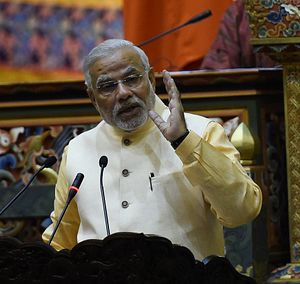This piece is the second in an analysis of the broad contours of Indian Prime Minister Narendra Modi’s foreign policy priorities in his first year in office. Click here to read the first part in the series, which covers Modi’s approach to the United States and China.
The Subcontinent and the Indian Ocean Littoral
The Modi government aims to reestablish India’s credibility and leadership in its immediate region and the Indian Ocean littoral. To this end, the recent passage of the Land Boundary Agreement (LBA) in the Indian Parliament paves the way for closer economic and security cooperation between India and Bangladesh. That the LBA received bipartisan support in India as well as in Bangladesh is encouraging, given the divisive nature of politics in both countries and India’s historically less-than-friendly relations with the opposition Bangladesh Nationalist Party.
The surprise victory of Maithripala Sirisena in Sri Lanka’s presidential election proved fortuitous for India. Under Sirisena’s predecessor, Mahinda Rajapaksa, Sri Lanka’s economic ties with China grew significantly, and in October and November 2014, two submarines of the People’s Liberation Army Navy docked in Sri Lanka, a move that India considered provocative. Sirisena’s election appears to have, for the time being, arrested India’s attrition of influence in the island nation.
Modi capitalized on the window of opportunity by paying an official visit to Colombo (the first for an Indian prime minister in nearly three decades), during which a series of economic and strategic agreements were concluded, including an important agreement for India to develop civil nuclear infrastructure in Sri Lanka and potentially build small-scale nuclear reactors. Modi’s official visits to Mauritius and Seychelles, also the first by an Indian prime minister in decades, demonstrated a desire to engage more meaningfully with countries in the Indian Ocean littoral, while pushing to augment India’s military and intelligence capacities in the region.
India, the Net Security Provider
The Modi government embraces a more active Indian role in providing security to the Indian Ocean Region. Historically, India has always played an important role as a net security provider in its neighborhood. Indeed, the Indian Navy’s official maritime military strategy envisages a constabulary role in the waters of the Indian Ocean as a “legitimate duty” that India and its smaller neighbors have come to depend upon.
To that end, India rose to the defense of the Maldives and Seychelles when they faced threats of coups d’etat. It deployed its naval assets and worked in concert with the U.S. in the rescue and rehabilitation efforts after the 2004 Indian Ocean Tsunami and continues to assist in anti-piracy operations off the coast of Somalia.
More recently, the Indian Navy played a lead role in rescuing Indian nationals and citizens of 41 countries following Saudi Arabia’s military campaign in Yemen. India’s former Navy Chief Adm. DK Joshi observed that “India’s standing as a benign power….[makes India] a preferred partner for regional security,” a role encouraged by Indian Ocean littoral states, East Asian democracies, and the United States. India also provided vital assistance to Nepal following after the devastating earthquake in April 2015 that resulted in 8,000 deaths.
However, India’s ambitions are circumscribed by issues pertaining to force structure and strength. India’s domestic public sector industries have also been incapable of meeting the needs of its armed services. Moreover, India’s general aversion to military groupings and partnerships outside of a UN mandate have limited its partnerships with other powers in the Indian Ocean Region, including the United States.
Ultimately, capacity building is a long-term project requiring the liberalization of the defense manufacturing industry, streamlined defense procurement, and commensurate budgetary allocations. However, the Modi government can further India’s regional ambitions and offset some challenges by being more open to partnerships with the U.S., NATO, and other powers in operations targeting terrorism, piracy and trafficking in the waters of the Indian Ocean.
Pakistan
It is clear that the Modi government does not accord the same priority to Pakistan as the previous Indian government. Despite a spate of terrorist incidents culminating in the November 26, 2008 Mumbai attacks and a series of provocations along the Line of Control (LoC) and International Border (IB), the Manmohan Singh government continued to attempt to engage constructively with Pakistan as a matter of priority.
The Modi government has decisively departed from its predecessor in its handling of Pakistan. The day prior to Modi’s swearing-in, the Indian consulate in Herat, Afghanistan was attacked by the Lashkar-e-Taiba, a veritable arm of the Pakistani Army. The Pakistanis attempted to test Modi again in the fall of 2014 through a series of provocations along the LoC and IB, but apparently weren’t quite prepared for the disproportionate response that the Indian Army delivered to them.
With the continued mockery of a trial in Pakistan to bring the perpetrators of the 11/26 carnage to book, a hardening of positions in Islamabad even on trade, and an unending series of wild accusations against India’s intelligence agencies, the Modi government appears to have concluded, quite rightly in the views of this writer, that Pakistan is just not worth the hassle. India’s western neighbor will continue to remain a priority insofar as security threat mitigation is concerned, but there will not likely be an appetite for the almost carnival-like iterations of “peace talks” characteristic of previous governments.
































